Mark and Maya had a restless night. I did a little bit better, staying covered by a sheet. The heat and humidity in Salta are still relentless, this time of the year. It is mid-March 2023. Fall is around the corner in the southern hemisphere, but we had forgotten what it is like to live in a jungle-like setting at barely 4,000ft (1,200m). The day time temperature soars at around 95 degrees Fahrenheit (35°F) and – unlike in the desert or the Andes Mountains – it barely cools off at night. Tiny no-see-um bugs (gnats) make their way through the mosquito screens, so if you leave yourself exposed, you’re itchy as well as sweaty.
We decided to stay at an established campground for a few reasons: it would be quieter than anywhere else in this sizeable city, it is affordable ($5 a night), there are hot showers, toilets, trash cans, and potable water, I had a project with a tight deadline, and the sites are level and shady.
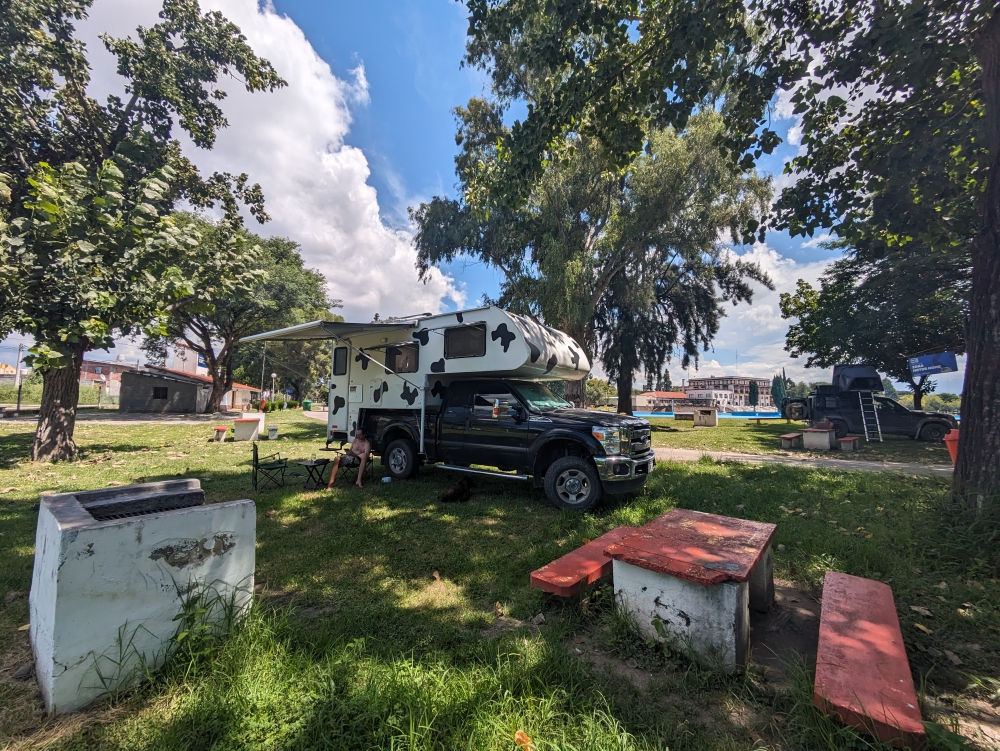
Shady spot at the campground
When we arrived, yesterday, we found a relatively shady spot next to a tree that didn’t obscure our roof-mounted Starlink satellite internet antenna. By this morning, however, our lithium battery is almost drained from being parked in the shade, running all our fans at high speed, and an inefficient fridge that never turned off, because of the heat. Yeah, this is still our expensive, over-priced Isotherm compressor fridge that we bought brand-new in the US, inconveniently replaced in Texas before leaving the continent, and have struggled with since!
Apart from the “validation step,” I finished my translation job, after a sweaty and tough afternoon and evening and – because we are trying to keep our stay to a minimum due to the uncomfortable climate – I have a busy day planned. The idea is to complete all our sightseeing and errands in Salta within one day and head to a higher altitude.
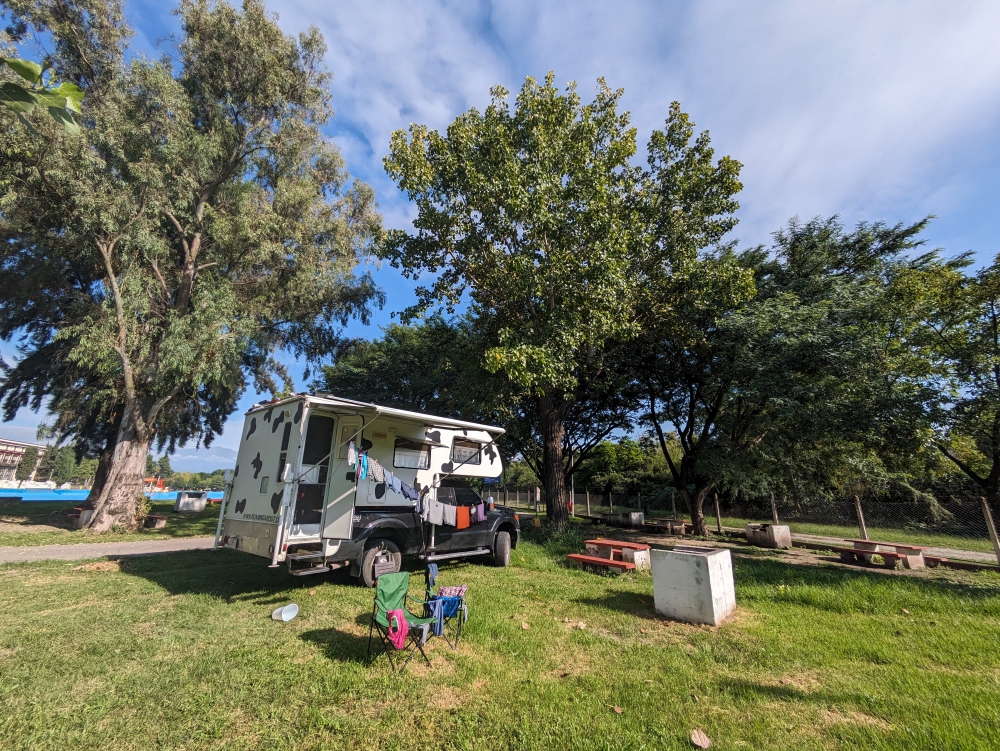
Thirsty Bella in the sun, with laundry strung up
Everything that needs to be done should happen between 8am (when the sun comes up) and 10am (when the heat becomes unbearable). Of course, that is impossible. Because we have unlimited water at the bathroom sinks, I wash our underwear, socks, and shirts by hand. We hang everything up on a line in the sunshine. Then, I prepare for a short visit into the historic center. Mark is not interested in joining – it’s too hot – and stays home with Maya. Ideally, we move the camper in a shady spot, but we need the solar power to charge our battery and our laundry is strung alongside Bella.
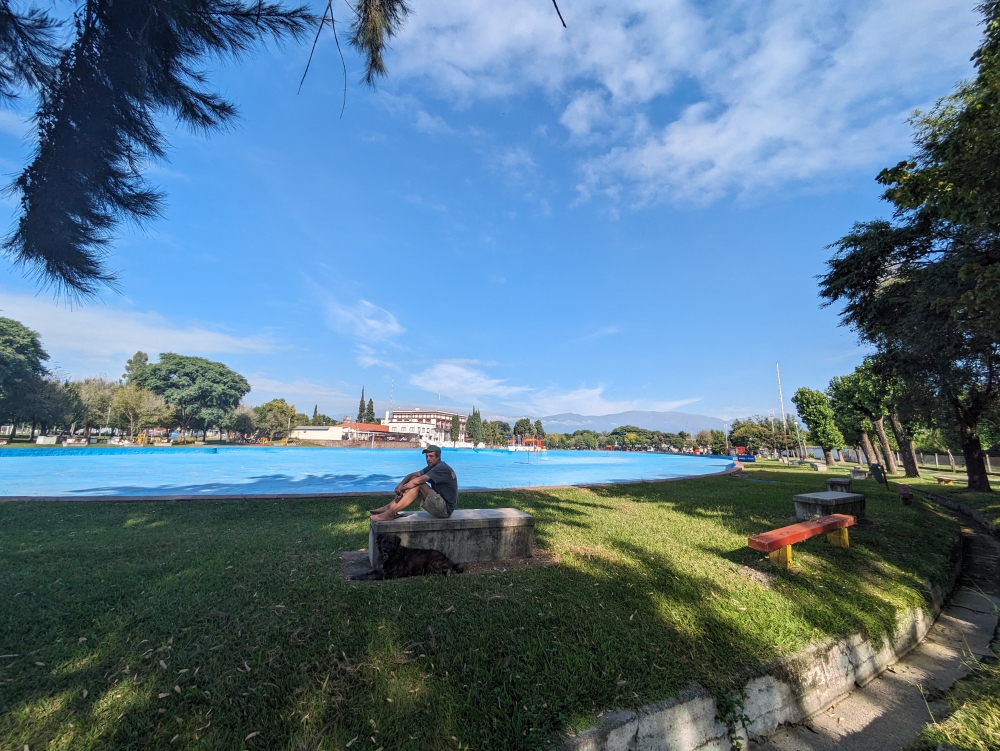
Mark and Maya found cooler weather in the shade – the pool is empty now and for ten out of the twelve months
I leave my family by a shady picnic bench and walk to the entrance of the campground, at the opposite end of the grounds. Sweat drips down my face when I inquire about ways to reach town. The public bus stops right in front and is cheap, but you need a card. Colectivos are affordable as well, but they don’t stop by the main square (my destination) and I have no idea where to grab one. A taxi it is. For the first time on this South American trip, the vehicle is metered. Progress is slow and I watch with dread how the meter keeps climbing. When the price reaches the equivalent of $2, I ask the driver to stop and hop out. I’ll walk the last bit.
The reason I didn’t leave home sooner to explore downtown Salta is because my main purpose of this excursion – the MAAM, an archeological museum with interesting displays and child mummies – doesn’t open until 11am. By leaving at 10am, I planned to see the square and colonial churches before eleven, and return home after my museum visit.
For the next 45 minutes, I find and enter the two main churches, Iglesia San Francisco and Iglesia Catedral. They are both stunning, inside and out, but I can only take photos in the first one, since a service is in progress in the cathedral.
I take a little breather in the shade of the beautiful 9th of July Plaza and fill the rest of my time with a stroll through the cool-ish pedestrian zone. This is a shopping strip, so nothing draws my attention.
At exactly 11am, I reach the MAAM, only to find tons of visitors already in line. Yes, Argentina is touristy and the towns, roads, and viewpoints have been busier than elsewhere this last year. I patiently cue for twenty minutes until I reach the ticket booth. My trusty app iOverlander told me the entrance fee should be $2, which is within my budget. I did not realize, however, that this info is a few months old!
When I approach the pay station, my eyes are drawn to the price list. Foreigners pay $8 to enter. What? That is a serious increase and too much for me. I take a photo of the sign to update iOverlander, and – disappointed – turn away from this attraction. I wish I saw these prices earlier!
On my walk to a shady area, I regret wasting this precious time in line, but I am even more disappointed in other overlanders not updating information in this free and otherwise beneficial app that we all use and rely on.
It has come to our attention that from the moment we arrived in Argentina, current info and regular photos are missing when we check campsites and attractions. In the most popular and visited country on this continent… We don’t understand the attitude of only using and never contributing. This app survives on updates from people like us – and there are many campers in this part of the world. If I knew entry to the museum would be $8, I might not have left the campground this morning and focused on other crucial tasks.
On a very important side note: because of the heavy inflation and strong devaluation of the Argentinian peso, prices (for fuel, groceries, restaurant meals, wine tastings, …) have doubled, if not tripled or quadrupled in the last months!
To get in a better mood, I buy pastries at a local bakery for later and a soft-serve ice cream cone for 80 cents. At least these things are still affordable. I walk a bit out of the city center in the direction of our campground to save on cab money and hail a driver. He makes good progress and the traffic lights are in my favor. I anticipate paying $1.50 for this ride, the normal fee. Things are looking good, until the driver turns away from our destination and makes a detour for no reason. That’s why I prefer taxi rides with an agreed-upon rate! That way, tourists are not taken advantage of and have a leg to stand on.
When we are close to the campground and the meter shows more than $2, I jump out prematurely again and hand him $2. I think he realized he got caught…
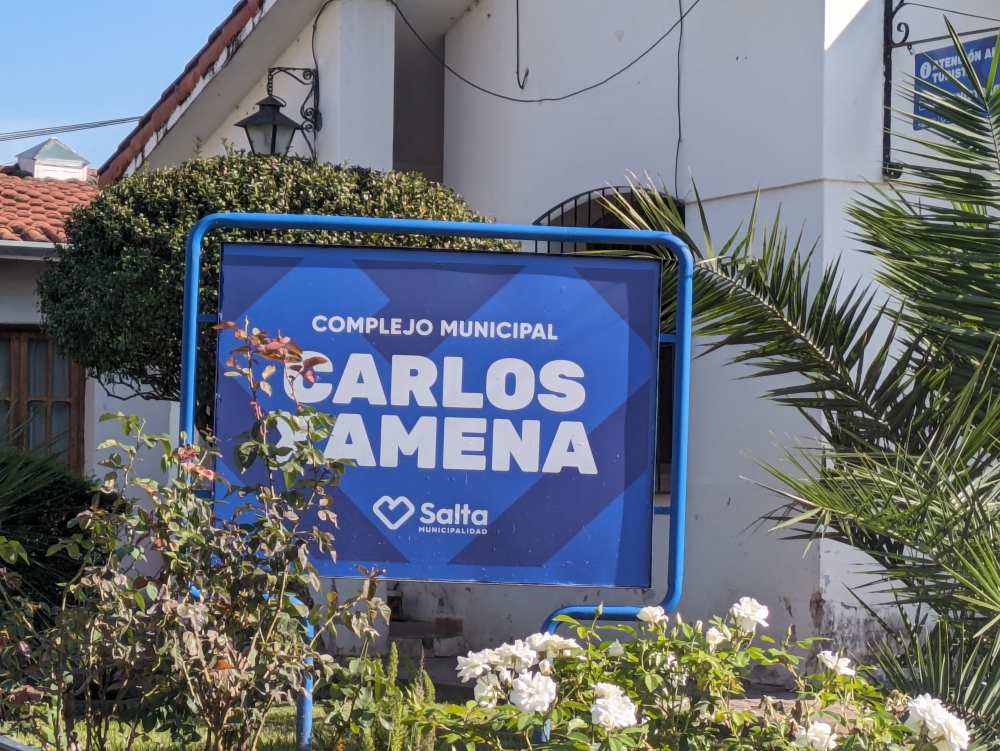
Carlos Xamena – not the easiest name to remember when taking a cab back
I rush to the toilet and make my way back to our campsite. Maya runs towards me, very excited. Mark tells me she was looking for me the entire time I was gone and seemed to have missed me. That’s a first! I guess after five years, she finally realizes she could love and be attached to two caretakers.
It’s noon now and I quickly check my inbox. There are multiple emails regarding the last step of my job, a notice of “deadline overdue,” and my realization that – apparently – this work should have taken priority. Unfortunately, this particular company is known for never explaining anything ahead of time.
When I try to finish the task, I can’t get into the program. I’m stuck and I need to deliver. Again, I notify my manager of this issue, while waiting for a response. We have a busy afternoon and it is only getting hotter. I eventually receive an answer that I can do the work later, so we eat lunch and pack up.
Before checking out of the campground, Mark fills up our potable water tank and I take a quick shower in the public bathrooms. Around 1:30pm, we hit the city roads again. First stop: a gas station. Second stop: a fruit and vegetable market building. Google sends us the wrong way. We pass the location and find ourselves dealing with a tricky traffic situation. To make matters worse, while we wait in front of a red light, the power goes out. None of the traffic lights work anymore and chaos ensues. Too many air conditioners must have blown the electricity grid!
Eventually, we reach our Google destination, but the parking lot is empty. When I slide out of the car to check, the building appears to be a warehouse. There is no produce here. An employee explains where the real market is, but tells me with a sad face that this place closes at 2pm. It’s 2pm.
Again, we have to make the necessary detours through defective lights to get back on track. We quickly stop by the dark supermarket and run in and out to grab discounted Argentinian wine. Luckily, the credit card machine works. I guess those machines don’t need power? Or do they have a back-up generator?
We can’t leave Maya in the camper for too long as the heat is appalling. On the drive out of town, we buy a few pricey bananas at a vegetable stand, before bouncing around on uneven, damaged, paved roads towards the mountains.
I ask Mark to pull over after the worst bump. As expected, towels and shoes have jumped from their hooks and pouches, a basket with condiments fell over, and our dishes have flipped. Sigh. We do miss the Chilean roads!
After an hour or two, we reach the hills and get settled next to a brown, rushing river around 5pm. It’s still pretty hot. I video chat with my parents for an hour – Thursday is our usual calling day – and finally finish this translation project I’ve been working on for days.
As the sun sets around 8pm, we have a healthy dinner inside, accompanied by a bottle of tasty white wine. We prefer to sit outside, but the bugs are too annoying. After the dishes, we restrict ourselves to 15 minutes of internet time. Our power issue remains, because of the inefficient fridge being on at all times, so we can’t use Starlink too long. It sucks power as well.

Maya helps me with work
I use my online time to check emails, practice Spanish, and reply to Facebook comments. Then, I go offline to write my diary entry and read another chapter in a sailing memoir I promised to proofread. By 10pm, I’m exhausted. I listen to the rushing river that overpowers the traffic noise and doze off.
Next up: Our monthly expense report for March 2024.
Curious about a previous ten-year chapter in our nomadic lives, which includes eight years aboard a 35-foot sailboat in the tropics with dogs, check out my compelling, inspiring, and refreshingly honest travel memoir:


























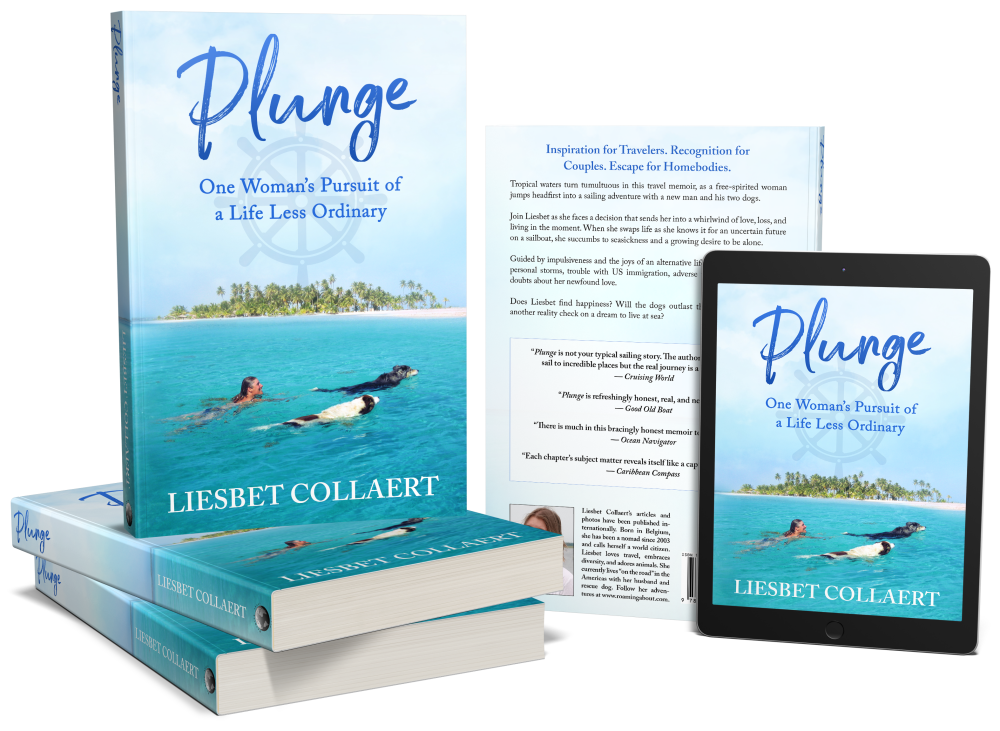




March 28, 2024 at 14:26
It is unfortunate that SO many travelers are in that “vacation state of mind” = pure consumers and doing nothing to benefit their fellow travelers — much less anything for the greater good. 🙁 Annie suggested that maybe without cell phone service, they’re unable to do updates? But doesn’t iOverlander still work when you’re offline?
March 29, 2024 at 20:09
Hi Jim!
Thanks for reading and commenting.
I feel like our world is becoming more and more selfish, no matter where we travel and/or live. The difference between the RVers we met in Central America twenty years ago and the ones we (almost) meet now in South America is crazy. Back then, seeing another camper would make you stop along the side of the road to chat and hug whenever you end up camping at the same spot.
Now, everyone is doing their own thing. We rarely meet anyone, let alone a kindred spirit. Lots of youngsters and millennials out here who are into Instagram, YouTube, and checking things of their “bucket list” as if that’s all that matters. Anyway, a very different attitude and atmosphere.
Annie might have a good point, but, these days, 1) everyone tries to always be online, either via cell data or Starlink (it’s insane how many overlanders have it now, including us), and 2) you are right, iOverlander works offline, which is one of its best features.
So, I think the not posting, adding, commenting, or updating comes down to laziness, not caring about others, and/or people having issues with the app.
March 28, 2024 at 14:48
So many challenges to overcome. I’m surprised the temperature is till that warm at 4,000 feet. Then, the annoying bugs must test your patience. Better luck in April.
March 29, 2024 at 20:12
Hi Pete,
I’m sure the temperature will start dropping soon, as the fall has started in the Southern Hemisphere. Otherwise, we have to escape into the mountains, to the beach, or further south! 🙂
It is quite interesting about the elevation differences. You could be at 5,000ft in one place and be comfortable, while elsewhere at 5,000ft it is boiling. So, there are other factors at play than just elevation.
March 28, 2024 at 15:59
Bugs and heat and humidity—maybe cooler temps will “cure” such annoyances. I do like the cathedral views; I wonder if the interiors are cooler. I’m glad you have translation jobs, but it seems even those come with challenges.
I never realized that solar power was so essential to things running smoothly, so finding a shady parking space comes with its down side too.
Like Pete, I hope you have fewer trials in April. 😀
March 29, 2024 at 20:17
Hi Marian,
I did realize that all those months we traveled in the high Andes and slept with two sleeping bags, I was never uncomfortable temperature wise! So, I guess I prefer cooler and dryer weather to hotter (and more humid) weather! 🙂 And, I also realized that above 10,000ft, we never had mosquitoes or no-see-ums.
Inside the churches it was cooler. If we could park in the shade, ideally with a breeze, the temps in Salta would have been more manageable, but you picked up on the solar panel problem then. It seems like everything on the road comes with pros and cons, from the sun to the rain, to the elevation, to the location.
At higher locales, we never had the power issue. Because it was so cool and sunny out, we didn’t need shade and our fridge behaved. Ha, another advantage to higher altitudes! 🙂 But we could never sit outside to relax with a drink…
March 28, 2024 at 19:00
Hi, Liesbet- Thank you once again for taking us on this incredible adventure. Thank you also for the reminder about the importance of reviews and user updates!
March 29, 2024 at 20:19
Hi Donna!
Thank you for joining in the reading and commenting department! 🙂 I think like in every facet of life, there are people who contribute (to resources) and others who don’t. I know which side you belong to, especially when it comes to reviews. 🙂
March 28, 2024 at 21:15
That’s something I hadn’t thought of–that solar power means you have to be in the sun, which might be way too hot!
March 29, 2024 at 20:22
Yep! In colder climates, we didn’t have this problem with the solar panels. It’s kind of a catch 22 in hot climates. We need more power to be comfortable (have a cold fridge, run the fans), yet, we are less comfortable due to the sweating and not being able to sleep. For that, the shade would be better. We are very busy monitoring our systems at the moment! 🙂
March 29, 2024 at 07:42
The whole experience sounds awful. Time to leave the country. Shame people don’t send updates to that app. Of course, if inflation is that bad, it might be changing so rapidly people can’t keep up.
March 29, 2024 at 20:24
Hi Alex,
Yes, prices are changing crazy fast and it’s hard to keep up. I agree with that. But any updated information will still help others. It’s better to have somewhat of a feel about something, than none at all.
Argentina is quite big, so we are confident we will find areas we like. Especially further south, which is getting too cold to visit now. And, there are a few neighboring countries to explore as well. 🙂
March 29, 2024 at 10:24
Hi Liesbet, I’m glad to read you made it safely to Argentina. I hope you experience with Argentina gets better and better and you get to see Iguazzu Falls. Bugs, heat and humidity are not fun to deal with. I visited Argentina in November and had nice, moderate weather.
March 29, 2024 at 20:31
Hi Natalie,
We do believe that the further south we travel in Argentina, the better we will like it. But, the seasons are turning, so we will remain above the Santiago-Buenos Aires “line” until the austral spring.
Yes, we do plan and hope to visit Iguazu Falls at some point, but probably on our way back north on the continent. We will see what happens. November sounds like a great month to visit this country!
March 29, 2024 at 14:22
It never ends, does it? I guess annoyances and unpleasant surprises are all “part of the adventure”, but you’re much more tolerant than I would be. I think if it was me, I’d have cancelled the whole trip during the struggle to transport the camper to South America. 😉
I hope things get better for you soon!
March 29, 2024 at 20:35
Hi Diane!
You got it. It never ends. I am honestly considering to not post so much about our travels anymore, because it is starting to come across too negatively. I guess exploring North America in a camper is just much easier, comfortable, and straightforward. Of course, we enjoy the adventure, but I am now wondering if all those people traveling through the continent at twice our pace might be the smarter ones! 🙂
Yeah, if there is one thing that’s missing in this lifestyle – I feel – it’s comfort. And familiarity. And ease. And convenience. Hmmm. Well, I could keep going for a while with this, haha.
March 29, 2024 at 14:30
Great post for us armchair travelers.
Interesting note about inflation. I had recently checked out the prices of the refugios in Patagonia and my jaw dropped. I had looked up the cost years ago for the do-it-yourself trek and they seemed quite inexpensive. Given the drop in the peso one might think the refugio price in US dollars might stay steady or go down however that doesn’t seem to be the case. Perhaps I’m missing something as I haven’t researched it fully and the 24/25 season reservations don’t seem to be up yet. I hope I’m wrong. Either way it seems worth the price for those who can afford it and hard for those who can’t.
I hope the sailing memoir was good :)!
March 29, 2024 at 20:45
Hi Heidi,
The sailing memoir was excellent! And I wish its author all the success in the world. 🙂
What’s happening in Argentina – related to visitors – is that the prices have doubled or tripled and the Blue Rate (there are three or four different currency values of the peso) and Visa card values have remained the same. Therefore they have much less value than before, making life more expensive for us as well as the locals, if that makes sense.
On this trip, we have realized quite a few times that the rich people have more and more of an advantage. As things become unaffordable for some, there are others who don’t care and are not affected by it. So, they are the ones who will be able to visit the Galapagos, fly to Easter Island, drink and eat at fancy restaurants, buy the high-quality wine, and get to visit certain attractions. C’est la vie!
March 29, 2024 at 15:16
I’m glad to see Maya is so helpful with your work!
March 29, 2024 at 20:36
Maya is the best, Anabel. It is so cool that after all these years, we are still learning from each other and she is still improving her behavior, skills, and cuteness. 🙂
March 29, 2024 at 16:13
I love reading your posts, Liesbet, but wonder how much ‘fun’ you’re having if you feel you can’t spend $8 on touring such a wonderful museum after paying for taxi rides to get into town. I hope the no-seeums and horrendous heat are no longer issues as you reach higher altitudes.
March 29, 2024 at 20:39
Hi Annie,
Of course, you are right. Mark and I can be too nit picky about money sometimes, but we feel like we have to draw the line somewhere and – you won’t be surprised at this – we have principles. A fee that goes from $2 to $8 – quadruple the amount – was just too shocking to adhere to. On hindsight, the museum might have been worth the money! But… I have seen mummies before and I’d rather spend that $8 on a month worth of pastries at a local bakery. 🙂
March 30, 2024 at 19:28
Test comment. I wrote a longer one but it didn’t go through.
March 30, 2024 at 19:30
It worked that time! Anyway, Liesbet, I’m sorry that you missed the museum, especially after standing in line for so long. It must be hard for those who live there to budget. Prices changing daily can’t be sustainable. Hopefully you are now enjoying cooler temps.
April 2, 2024 at 19:17
Hi Janis,
Sorry you’re having trouble commenting here. I’m glad your second tries went through.
Yeah, I have to think about the Argentinians when I shop in the grocery stores. While everyone said (months ago) that this country was dirt cheap, that isn’t the case anymore. Sometimes I wonder how the locals afford to shop. The museums, parks, and other sites – and I’ve seen it at some restaurants as well – offer cheaper rates for locals, but at the stores, the price is the same for everyone.
After visiting Chile, we have somewhat of an idea what everything costs in both countries and we will go back to Chile for certain things that we are holding out on at the moment, while “struggling” without it for a little while.
April 2, 2024 at 19:13
Sorry to read that, Janis! Do you think the issue was on my end?
March 31, 2024 at 20:57
Hi Liesbet
Argentina has always been pricier than other South American countries (aside from Brazil). However, what used to get annoying was the 3-tier prices for flights, entrance fees, and anything else thrown in – a cheaper price for Argentinians, a higher price for nationals, then an exorbitant price for foreign tourists. I found that most times it was triple the price for tourists and while this is manageable on a 2 to 3-week holiday, it’s not on long-term (lifestyle) travel. While folks said “well Argentinians earn a lot less than you” and I get that, I just don’t like being ripped off at every turn just because I’m foreign, but it happens in many countries. 😉
We’re in the US right now and it’s super expensive on our falling Australian dollar, especially for accommodation and buses/trains. Boston made my eyes bleed even though we stayed for only one week. I miss the motorhome days. 😉
April 2, 2024 at 19:24
Hi Nilla,
Prices must have changed enormously here within the last decade. Before we arrived on the continent, I heard that Chile, Uruguay, and Brazil were the priciest countries. Nothing matches cheap Colombia so far and Ecuador wasn’t too bad either.
In Peru the fuel was crazy expensive, but this is worse in Chile. In Argentina it now hovers around $4 a gallon, not cheap either. My biggest shock here are the grocery stores, so we really stick to what we need and not what we want. Like in the US. We had hoped to eat out more often here, but that’s not on the agenda anymore either. Luckily, good, local wine is still relatively affordable!
Regarding the different rates, yeah, I’m not a fan either, but I remember this practice from when I backpacked in Southeast Asia in the nineties. I guess it’s up to us if we are willing to pay the steep prices or not. We usually don’t, so miss out on a bunch of things that way.
I can’t imagine how much it must cost to backpack in the US. Ouch! I think I’ll get sticker shocked this summer, after being gone for two years…
April 2, 2024 at 20:02
I guess prices are increasing as inflation in South American countries is spiralling out of control. Think I mentioned before that I would love to return to Venezuela, but it’s not ideal right now or has it been since I sailed there in 2008.
The only country in Southeast Asia I experienced differing prices is Myanmar but the government charges the prices so that the money goes to the corrupt government (did I say that? Whoops).
It’s proving difficult to keep to a budget so far in the US but we’re out of here on the 9th and head to Montreal. I’m hoping that prices might be a little more reasonable in Canada plus our dollar isn’t quite as bad against the Canadian dollar (although not on par either).
What is hideously expensive in the US is the price of museums. Most in Washington are free then out of Washington, it’s crazy prices like US$20-$30 per person for one museum, even here in Portland.
April 4, 2024 at 10:43
Hi Nilla,
Yeah, I think Venezuela is still off limits right now, safety wise. Although more and more overlanders are adding it to their itinerary. I’d love to visit the country one day as well. I had quick glimpses in the nineties, when I flew to Isla Margarita from Belgium and in 2012, when we stopped in the out islands with our sailboat. The mainland has been out of grasps since then.
Here in South America, it just seems to be Argentina, where the prices keep increasing fast and crazy, thanks to the new president. Elsewhere on the continent, things appear pretty stable. I’ve heard about the foreigner rates in Myanmar, but have never been. Even in 1997, the Taj Mahal in India had much higher entrance fees for tourists than for locals, as far as I remember. Back then, it was still affordable, though.
I can’t believe how expensive museums in Portland are! Wow! I’d have to skip them all. I’m so glad everything in Washington DC, on the Mall, is free, or I’d never visit any museum in the US. Luckily, the ones in DC are high class! 🙂
Enjoy Canada! It’s not so cheap there either… 🙁
April 4, 2024 at 12:32
A colleague I worked with in Jan last year was from Caracas and although I said I wanted to revisit Venezuela he told me “No way as it’s too dangerous”.
I hear the new president is truly stuffing up the economy. How to bankrupt a country…then they walk away rich – it’s evil.
I visited the Taj Mahal in 1985 and there wasn’t a fee then, or anywhere where I travelled to in India for the month. How times have changed…
It’s not just Portland, it’s Boston, Philadelphia and anywhere out of Washington. So, when you’re long-term travelling for a couple of years, it’s not affordable, as you guys know.
Thanks for the tip on Canada! 🙁
April 10, 2024 at 15:31
Hi Nilla,
I just remember cell/data service and fuel being expensive in Canada. We couldn’t get around the fuel prices (you probably can), but we only used free WiFi signals to get online, which mostly worked. Big department stores and their famous coffee shops usually have free WiFi available.
Yeah, Venezuela is a toughie. Overlanders are starting to visit again, solo or in convoy, and so far the only negative I’ve heard about is the huge amount of police checkpoints. Every few kilometers, there is one apparently. Not fun. But, fuel is cheap!
April 10, 2024 at 17:32
Just did a few days grocery shopping at the IGA in Montréal city. We don’t have a car to go out to the supermarkets further out, which may be cheaper. It’s not quite as expensive as the US, but is still expensive as we need to add 10% on everything for our falling dollar. 🙁
I didn’t realise travellers are starting to return to Venezuela. I remember the diesel was very cheap in 2008 but to fill a foreign boat up, we needed to hire an “Agent” to buy the fuel for us at a different price (but still cheap) and deliver it to us in drums. How ridiculously corrupt. We weren’t allowed to moor up to a fuel pump and buy fuel ourselves.
I’ve published several posts on Venezuela so If you’re going, check them out…
April 14, 2024 at 15:41
Yeah, I remember boating friends telling us about this fueling process in Venezuela way back when. Thanks for the info. I don’t think we will go there, unless something changes drastically on our way back north. Time will tell… 🙂
April 1, 2024 at 21:34
Shocking how quickly the prices rose there – just like Mexico. I did love that picture of Maya working hard on your laptop. LOL <3
April 2, 2024 at 19:26
Hi Debby,
We will manage financially, here in Argentina. The disappointment is that we had hoped to splurge more on eating out, as this was such an advantage here the last few years. In general, I don’t think we will spend more money, because we will remain careful with what we shop for and where we eat out. Just a pity that we have to pass on eating out more often. We had really looked forward to that for the last year. Anything can change on a dime!
April 4, 2024 at 10:19
Liesbet,
I can’t believe how much the price of the museum has gone up?? I know the inflation in Argentina is a big problem. Such a shame that people don’t update information on the iOverland app, it would have saved you a trip there.
I hope the temperatures will start improving soon, since Autumn is on the way. Here it has been wet…wet…wet. We are turning into frogs.
Lovely to see that Maya does love you after all…hahaha. Of course she loves you 🙂
April 4, 2024 at 10:47
Hi Gilda,
Having higher prices for museums, attractions, and restaurants is quite manageable for us (we just don’t go or restrict ourselves with this), but where it really hurts, is the fuel. That’s something we need and can’t get around. Last year, fuel was about 50 cents a liter in Argentina. Now, it’s double that, around $1 a liter. Imagine the difference of that on the budget. It’s pretty huge and we now regret not arriving here earlier. But, some things you can’t control or even anticipate.
Sorry to read (and hear) about all that rain across the Atlantic! We are driving south, so the temperatures are more manageable already. 🙂 And, yes, Maya does love me. On her own terms, and when Mark is (usually) not around, haha.
April 10, 2024 at 07:15
Just the heat and humidity you described would be like living in hell for me, Liesbet. I hope the tasty Argentina white white helped cool you down. I really could not cope with that heat and humidity.
The faulty fridge must be a nightmare with it sucking all the power. And those bumpy roads again! But at least you got to see some lovely churches. Were they cool inside?
I’ve seen signs of 2-tier prices for locals and tourists here in Swansea, but only for parking so far. I do wonder if it will be applied to other things in the future. Hopefully not, as I think it would damage the tourist season.
April 10, 2024 at 15:38
Hi Hugh,
The climate has been all over the place in South America, depending on whether we are driving in the Andes Mountains, the coast, or the jungle areas. I’ve come to realize that we (our camper and our bodies) are better equipped for cold temperatures than for hot and humid weather! And then to say that we lived and traveled in the tropics for ten years when we were sailing! It seems like a lifetime ago, haha.
Yes, the churches were cool – and dark – inside. A temporary relief from the heat. But, to be honest, if we could just sit in the shade all day with a nice little breeze, those temperatures in Northern Argentina would be doable. But, we need the sun for our power supply and we don’t ever just sit around! 🙂
I understand the two-tier prices when locals pay high amounts of taxes for, say, roads and parking lots. In that case it makes sense that tourists pay a little bit more. We’ve seen different prices here in Chile for toll roads…
Or, when we visit extremely poor countries, I understand that the locals get into attractions for free or for a minimal fee, while westerners pay more. But those are the only two occasions where I get it. Needing to pay different prices for the same amount of food, or having to pay three times the price as a local for a museum, that’s tough.